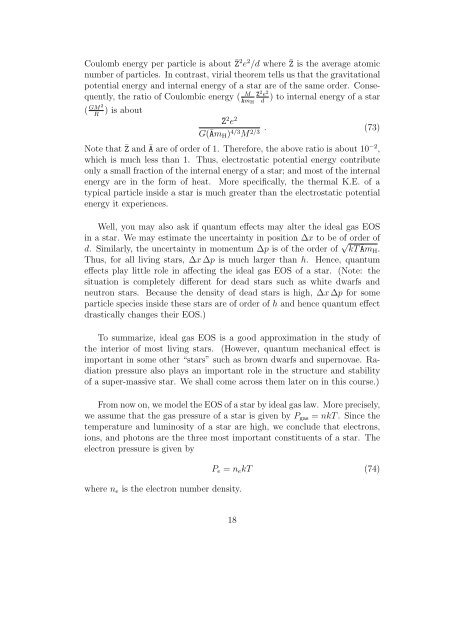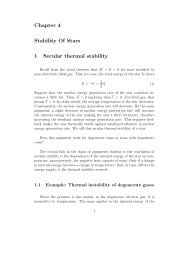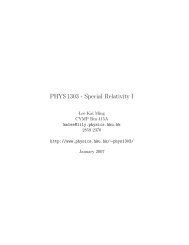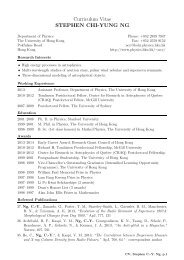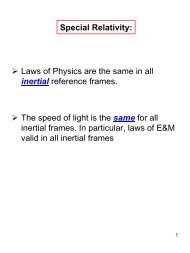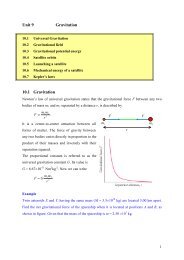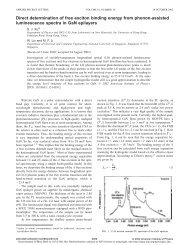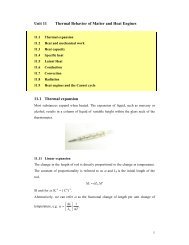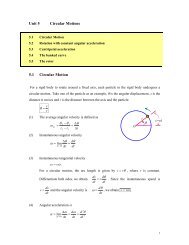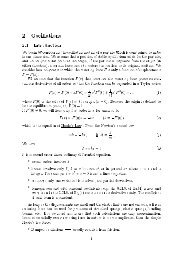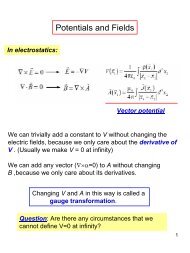Chapter 2 Stellar Structure Equations 1 Mass conservation equation
Chapter 2 Stellar Structure Equations 1 Mass conservation equation
Chapter 2 Stellar Structure Equations 1 Mass conservation equation
You also want an ePaper? Increase the reach of your titles
YUMPU automatically turns print PDFs into web optimized ePapers that Google loves.
Coulomb energy per particle is about ¯Z 2 e 2 /d where ¯Z is the average atomic<br />
number of particles. In contrast, virial theorem tells us that the gravitational<br />
potential energy and internal energy of a star are of the same order. Consequently,<br />
the ratio of Coulombic energy ( M ) to internal energy of a star<br />
( GM 2<br />
R ) is about ¯Z 2 e 2<br />
¯Z 2 e 2<br />
Ām H d<br />
. (73)<br />
G(Ām H ) 4/3 M<br />
2/3<br />
Note that ¯Z and Ā are of order of 1. Therefore, the above ratio is about 10 −2 ,<br />
which is much less than 1. Thus, electrostatic potential energy contribute<br />
only a small fraction of the internal energy of a star; and most of the internal<br />
energy are in the form of heat. More specifically, the thermal K.E. of a<br />
typical particle inside a star is much greater than the electrostatic potential<br />
energy it experiences.<br />
Well, you may also ask if quantum effects may alter the ideal gas EOS<br />
in a star. We may estimate the uncertainty in position ∆x to be of order of<br />
d. Similarly, the uncertainty in momentum ∆p is of the order of √ kT Ām H .<br />
Thus, for all living stars, ∆x ∆p is much larger than h. Hence, quantum<br />
effects play little role in affecting the ideal gas EOS of a star. (Note: the<br />
situation is completely different for dead stars such as white dwarfs and<br />
neutron stars. Because the density of dead stars is high, ∆x ∆p for some<br />
particle species inside these stars are of order of h and hence quantum effect<br />
drastically changes their EOS.)<br />
To summarize, ideal gas EOS is a good approximation in the study of<br />
the interior of most living stars. (However, quantum mechanical effect is<br />
important in some other “stars” such as brown dwarfs and supernovae. Radiation<br />
pressure also plays an important role in the structure and stability<br />
of a super-massive star. We shall come across them later on in this course.)<br />
From now on, we model the EOS of a star by ideal gas law. More precisely,<br />
we assume that the gas pressure of a star is given by P gas = nkT . Since the<br />
temperature and luminosity of a star are high, we conclude that electrons,<br />
ions, and photons are the three most important constituents of a star. The<br />
electron pressure is given by<br />
where n e is the electron number density.<br />
P e = n e kT (74)<br />
18


